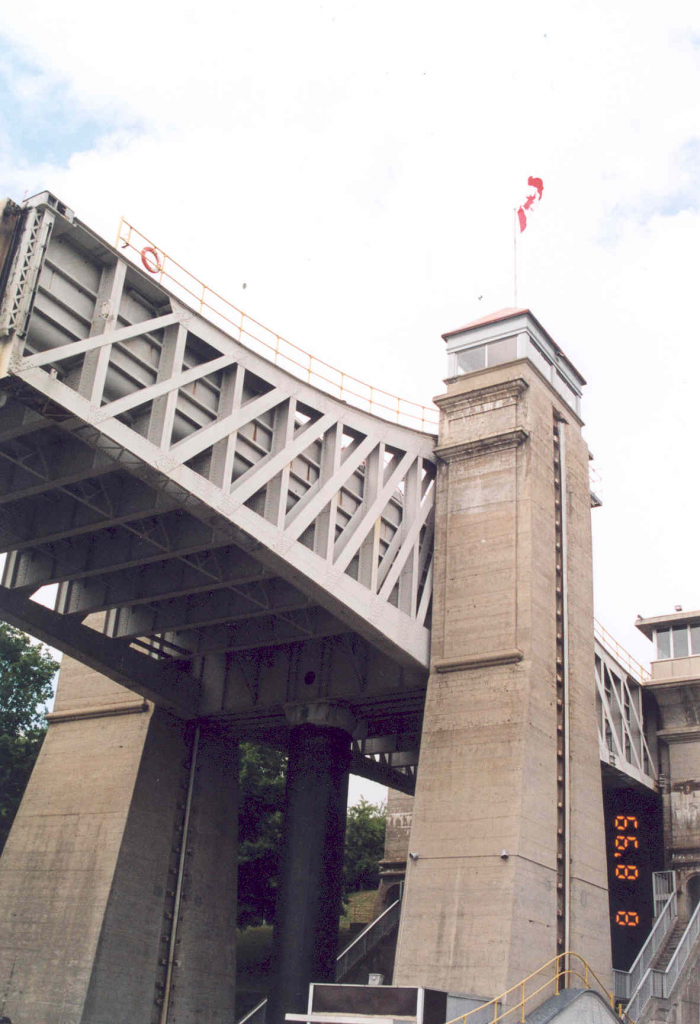
Site Location: Lat.: 44° – 18’ – 27” N.; Long.: 78° – 18’ – 4” W. (GPS: 44.3075332, -78.3010501). From the Highway 7/Landsdowne Street intersection, travel 1.2 km west on Landsdowne Street and turn right (north) on Ashburnham Drive. Proceed 2.1 km: the canal and lift lock are on the left (west).

Plaque Location: The plaque is mounted on a boulder in Westclox Park, near the Trent-Severn Walkway Lift Lock Visitor Centre. From the quay downstream of the west lift lock tower, walk west up the stairs: the boulder is between two trees at the top of the stairs.

Description: The Trent-Severn Waterway connects Lake Ontario, at Trenton, to Georgian Bay, Lake Huron, at Port Severn. It is 386 km long, including 32 km of man-made canals and 44 locks including lift locks at Peterborough and Kirkfield and a marine railway at Big Chute. The first lock in the system was completed in 1833 at Bobcaygeon and the last in 1920 at Port Severn. Nicol Hugh Baird oversaw the early years of surveys and construction, 1833-1844. Richard Birdsall Rogers oversaw much of the construction as Superintending Engineer of the Trent Canal from 1884 to 1906.


Nicol Hugh Baird (1796-1849) (Source: Library and Archives Canada/MIKAN 3704584)

Richard B. Rogers (1857-1927) (Source: mykawartha.com)
Historic Significance: The waterway was never commercially successful, due to its late completion, but it is one of Ontario’s major tourist attractions as a pleasure-boating route. Baird contributed significantly to the development of early canal and road systems in Upper and Lower Canada before 1840. The lift locks at Peterborough and Kirkfield and the marine railway at Big Chute were technically innovative for their settings. In particular, the bold decision by Rogers to construct the Peterborough Lift Lock using unreinforced concrete, instead of wood or limestone masonry, has proven successful and durable, and gave the fledgling cement industry in Ontario a tremendous stimulus. The steel rams and presses at the Peterborough Lift Lock were fabricated by the iconic Dominion Bridge Company of Lachine, Quebec.

Plaque Wording: National Historic Civil Engineering Site. CSCE. TRENT-SEVERN WATERWAY. NICOL HUGH BAIRD. Engineer during the early years of surveys and construction. 1833-1844. Canadian Society for Civil Engineering. Centennial 1887 – 1987.
SCGC. Site Historique National de Génie Civil. VOIE NAVIGABLE TRENT-SEVERN. NICOL HUGH BAIRD. Ingénieur pendant les premières années d’arpentage et de construction. 1833-1844. Société canadienne de genie civil. 1887-1987 centenaire.
Plaque Unveiling Ceremony: The plaque unveiling ceremony, on June 6, 1987, featured: Chris Thompson, CSCE President; John Lewis, Superintendent of the Trent-Severn Waterway; and others.
Links to Online Documentation:
Parks Canada, “Trent-Severn Waterway National Historic Site”.
Charles Foran, “Trent-Severn Waterway: The Waterway”, Canadian Geographic, 2010.
“Richard Birdsall Rogers – Life and Times of a Canadian Engineer”, digitalcollections.trentu.ca